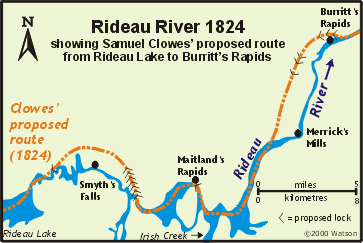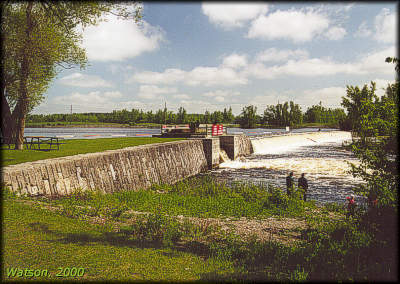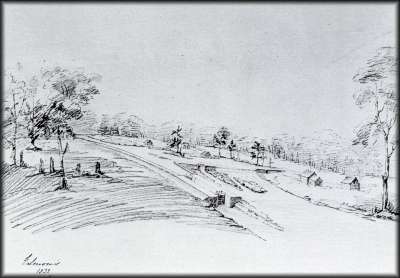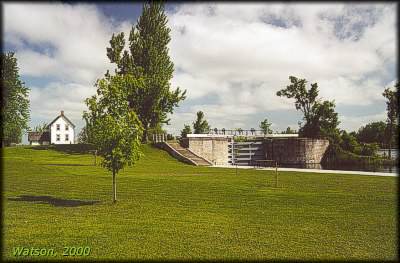Edmunds Lock 25
| location map | lockstation information |
The Setting
Upstream from Maitland's Rapids there was a wide, still water portion of the Rideau that then turned into a narrow, windy section of river which worked its way up to Smyth's Falls. MacTaggart in his 1827 survey characterized the area above Maitland's still-water as, "a chain of small ripples, not worthy of the name of rapids, for about three miles in length; yet, small as they are, their aggregate amount is considerable (being 12 feet); and ... the banks are extremely low …". Near the foot of the rapids, on the north bank, a settler named James Edmunds had cleared some land and erected a couple of log cabins.
The Plan
 Samuel Clowes' original 1824 plan called for a canal cut to leave the Rideau River at a point just below Edmunds Rapids and follow a route north of the river, bypassing Smiths Falls, and returning to the channel of the Rideau just above First Rapids (Poonamalie), a elevation difference of about 65 feet (20 m). A series of seven locks near the Edmunds end of this route would take the canal almost to the level of Rideau Lake (one more lock was planned at First Rapids to take the canal up to the level of Rideau Lake). Samuel Clowes' original 1824 plan called for a canal cut to leave the Rideau River at a point just below Edmunds Rapids and follow a route north of the river, bypassing Smiths Falls, and returning to the channel of the Rideau just above First Rapids (Poonamalie), a elevation difference of about 65 feet (20 m). A series of seven locks near the Edmunds end of this route would take the canal almost to the level of Rideau Lake (one more lock was planned at First Rapids to take the canal up to the level of Rideau Lake).
By changed Clowes' plans, maintaining the canal in the Rideau River channel and creating a slack water system. He planned to construct two sets of locks and dams, one set at Edmunds, and one set at Philip’s Bay. The original tender for the work in December 1827 was: "To construct a Dam and Lock on Edmond's Rapids. Dam 8 feet high, 400 feet long; and Lock 6 feet lift. Considerable Excavations of Rock and Clay will be at this place. To construct a Dam and Lock near to Phillip's Bay, Edmond's Rapids. The dam to be 8 feet high and 250 feet long; the Lock 6 feet lift."
Building the Locks
The contractor for this site was Bell, Richardson & Co.
 In the initial clearing of the area, which allowed for a more accurate survey, it was found that Clowes' survey was in error, that the total lift required was two feet less than Clowes reported and the banks of the river at Edmunds, higher than reported. This allowed By to do away with the second lock and dam at Phillip's Bay and instead build just one lock, with a slightly higher lift than planned, at Edmunds. In the initial clearing of the area, which allowed for a more accurate survey, it was found that Clowes' survey was in error, that the total lift required was two feet less than Clowes reported and the banks of the river at Edmunds, higher than reported. This allowed By to do away with the second lock and dam at Phillip's Bay and instead build just one lock, with a slightly higher lift than planned, at Edmunds.
In By's 1830 report he stated: "Upon a more careful Examination of the Banks of the River than it was possible to give (in consequence of the thickness of the woods) prior to forming the Estimate of Works which the Committee approved of, it was ascertained, that the Lift of the Lock, and height of the Dam at Edmonds might be increased so as to do away with the works required at Phillips Bay, not only with the greatest Security, the total Rise to be surmounted being 10 feet instead of 12 feet, but that from the alteration, a saving would also accrue. In consequence, I considered myself fully authorised to deviate from the original plan and to adopt the mode above stated, and by the addition of a Waste Weir to preserve the Dam from the effects of the Spring Floods. I consider that perfect Security to the Works at Edmunds Rapids has been obtained and the Original Plan much improved upon."
 |
Weir and Overflow Dam at Edmunds
photo by: Ken Watson, 2000
Looking north at the beautiful stonework leading up to the weir. In behind the weir is the overflow dam. On the right are some anglers taking advantage of the backwaters. |
Work proceeded on the building of the lock and dam with little incident. The dam was constructed as a stone arch overflow dam, although as noted in By's report, he had a waste weir installed on the lock side of the dam to protect the works from spring floods. An alteration in the construction of the dam was to use gravel and broken stone as a substitute for clay puddle as had been successfully done at Clowes. The waste weir was built of masonry.
A single lock, with a lift of eight feet, eight inches (2.6 m), was built on a clay foundation. This necessitated the use of either an inverted masonry arch or a wooden floor. By opted for the use of a wooden floor, noting, as he had at other lockstations, that wood, when kept immersed in water, was as durable as stone. It was also considerably cheaper.
In the early 1840s, a defensible stone lockmaster's house of the same design as that built at Kilmarnock, was constructed here.
 |
Edmon's; 1832
John Burrows, pencil sketch, Public Archives of Canada
The lock, waste weir and overflow dam at Edmund’s Rapids. The buildings below the dam belong to James Edmunds, the first settler in the area. |
Through the Years
In the 19th century, mostly routine maintenance was done on the lock and dam. A few problems came up such as in 1841 when one of the side walls developed a bad bulge and had to be rebuilt. In 1905, when the frost left the ground, the north upper wing wall looked like it might collapse. It was secured with chains anchored to the bank and was repaired at the end of navigation season. In 1906-1907 the weir was reconstructed.
The defensible stone lockmaster's house, built in the early 1840s, was torn down in 1905 and replaced with a two-storey frame house. This house was originally painted the same slate grey colour as the lock gates with trimmings in white.
Edmunds or Edmonds? The lock is named after James Edmunds, so that is the correct spelling. However, Edmund’s name was often spelled phonetically as Edmonds (or Edmons). Colonel By in his reports used both Edmunds and Edmonds. For many years the lockstation was known as “Mills Lock” after the name of the first two lockmasters – this, for a time, solved the Edmunds/Edmonds problem.
 |
Edmunds Lockstation
photo by: Ken Watson, 2000
Looking north at the lovely lawns, beautiful stonework of the lock, and the wood frame lockmaster's house. |
The Lockmasters to 2000
The first lockmaster was Edward Mills, recommended by By. He retired in 1867 and was replaced by his son, William W. Mills. William died in 1897 when he was thrown from a buggy and was succeeded by Henry W. Hutton of Smiths Falls who retired in 1921. In 1922, John (Jack) Dalton became lockmaster and he served until 1956. He was followed by Ed Moore from 1958 to 1960; Gordon Eldin Stienburg from 1960 to 1962; G.A. Kendall from 1962 to 1963; J.L. Jones from 1964 to 1967; E.T. Hodge from 1968 to 1971; Gerald Hutichson from 1971 to 1985 (Clarence Curry and Ken Bygrove may have acted during this time); and unknown from 1975 to 1985. Ron Hyland served from 1985 to 2000, he also became lockmaster of Kilmarnock when the position was combined in 1995.
|